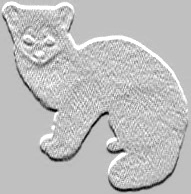

|
The SABLE Server: General Information |
The SABLE server can be used for predicting real valued relative Solvent AccessiBiLitiEs of amino acid residues in proteins, and for improved prediction of secondary structures using evolutionary profiles and predicted relative solvent accessibility of an amino acid residue as a fingerprint of the overall packing.
SABLE stand-alone version can be downloaded from Source Forge. Older versions can be accessed here.
Currently, the SABLE server is also being evaluated by the EVA meta-server. As of December 2003, using a set of 42 proteins derived from the non-redundant structures that were submitted recently to the PDB and had no homology to our training set, the SABLE server was estimated by EVA to achieve accuracy of 77.7% in terms of average Q3 measure and 76.5% in terms of average SOV measure. Please, refer to the EVA page for current accuracy estimates. For the three state prediction we use the following conversion of the secondary structure states provided by DSSP: {G,I,H}=>H; {B,E}=>E; {T,S,L,C}=>C.
As for relative solvent accessibility (RSA) prediction, SABLE reached accuracy of about 77% for the two state problem, with RSA of 25% separating the buried and exposed residues (the base line in this case is about 67%). However, SABLE avoids in fact crisp definition of descrete classes, enabling accurate predictions for a range of RSA.
A table represents the prediction accuracy of the target models of the CASP competition. Prediction was performed only to models with no sequence redundancy to the SABLE training set.
| Secondary structure | Solvent accessibility | ||||
|---|---|---|---|---|---|
| Set | No. proteins | Q3, % | SOV, % | MAE | CC |
| CASP 6 | 48 | 79.6 | 78.3 | 14.6 | 0.67 |
| CASP 5 | 41 | 76.1 | 77.6 | 15.8 | 0.63 |
| CASP 4 | 25 | 78.9 | 73.0 | 15.7 | 0.63 |
Use of the SABLE web site and server is at your own risk and no liability is accepted for any loss or damage arising through use of the web site and the SABLE server predictions. Access to the service is available free of charge for academic users. However, this service must not be used for direct commercial gain. We reserve the right to withdraw the service or make access subject to specific terms of use, including payment, for users making excessive use of the service.
SABLE makes use of the PsiBLAST program for sequence alignment by S. Altschul and colleagues and we hereby thank the authors of PsiBLAST for making their program available as a public domain package. It is our intention that SABLE will be used in a similar spirit to advance scientific research.
R. Adamczak, A. Porollo, J. Meller, Accurate Prediction of Solvent Accessibility Using Neural Networks Based Regression, Proteins: Structure, Function and Bioinformatics, 2004, 56:753-67.
R. Adamczak, A. Porollo, J. Meller, Combining Prediction of Secondary Structure and Solvent Accessibility in Proteins, Proteins: Structure, Function and Bioinformatics, 2005, 59:467-75.
M.Wagner, R. Adamczak, A. Porollo, J. Meller, Linear regression models for solvent accessibility prediction in proteins, Journal of Computational Biology, 2005, 12:355-69.
A. Porollo, R. Adamczak, M. Wagner and J. Meller, Maximum Feasibility Approach for Consensus Classifiers: Applications to Protein Structure Prediction, CIRAS 2003 (conference proceedings).